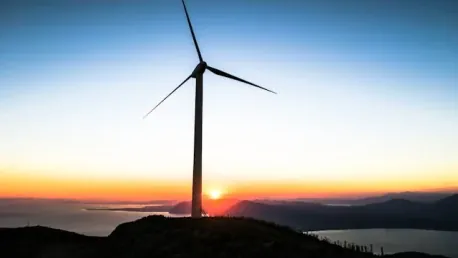July 2024 marked a significant milestone in Ireland’s renewable energy journey, with wind energy playing a crucial role in powering the nation. Data from Wind Energy Ireland (WEI) and other credible sources reveal that it was the third-best month on record for wind generation in July, underscoring the sector’s growing importance. Here’s an in-depth look at how wind energy performed and its broader implications.
With an impressive output of 656 gigawatt-hours (GWh) of wind energy, July 2024 has set the stage as the third-highest month on record for wind power generation in July since comprehensive data collection began. This substantial contribution highlights the vital role that wind energy plays in meeting Ireland’s electricity needs. As the country progresses toward its zero-carbon targets, the consistent growth in wind energy generation is both encouraging and pivotal for its future energy landscape. Such performance levels are not only crucial for securing stable energy supplies but also for strengthening Ireland’s commitment to sustainable practices and reducing carbon emissions.
This significant output underscores the growing reliability and efficiency of wind farms, which are increasingly becoming an integral part of the national energy grid. The increasing reliance on wind energy is a testament to the advancements in technology and infrastructure that have allowed this renewable source to flourish. As fossil fuels become a less viable option due to environmental and economic reasons, the sustained high performance of wind energy is a reassuring indicator for Ireland’s renewable energy agenda.
Strong Performance in Wind Energy Generation
The regional breakdown of wind energy contributions showcases distinct variations among counties. Cork led the charge with an 80 GWh output, followed by Kerry at 66 GWh, Galway with 55 GWh, Mayo producing 54 GWh, and Tipperary contributing 46 GWh. Cork, Kerry, and Galway together accounted for nearly one-third of the national total for the month, illustrating the importance of regional wind farm development. These substantial contributions from specific regions point to the favorable wind conditions and well-established infrastructure that bolster their outputs.
These statistics reveal the uneven distribution of wind energy capabilities across the country, prompting a deeper look into the potential of each region. Understanding these variations is crucial for future planning and development, ensuring that investments are directed toward areas with the highest potential. These top-performing areas not only contribute significantly to the national grid but also serve as benchmarks for future renewable energy projects across Ireland. The observed performance can guide targeted investments and policies that maximize the efficiency and effectiveness of Ireland’s wind energy strategy.
Wind energy’s influence extends beyond just electricity generation; it also impacts the cost of electricity. In July 2024, Ireland’s average wholesale electricity price stood at €110.94 per megawatt-hour (MWh), slightly higher than the previous month’s €107.74. However, on days with peak wind generation, the average cost of electricity dropped to €70.30 per MWh, a 36% decrease. This economic impact highlights one of the key advantages of wind energy—its ability to lower electricity prices by reducing dependence on imported fossil fuels.
Broader Implications and Trends
Affordable and reliable clean energy is essential for maintaining consumer confidence and supporting Ireland’s transition to a zero-carbon society. Justin Moran, WEI’s Director of External Affairs, emphasized wind energy’s role in substituting imported fossil fuels with domestically generated power. This doesn’t only foster sustainability but potentially lowers household energy costs. By producing more homegrown energy, Ireland enhances its energy security while also reducing its carbon footprint.
The Commission for Regulation of Utilities (CRU) further indicates the economic benefits, noting that Irish wind and solar farms will pay back nearly €17 million to consumers over 2024 and 2025. This cycle of savings and reinvestment strengthens the argument for renewable energy as a financially viable alternative to traditional fossil fuels. Lower energy costs generally translate to broader public acceptance and greater support for renewable initiatives, which is crucial for long-term sustainability.
While wind energy is at the forefront, other renewable sources are also gaining traction. Solar power, for instance, accounted for 7% of Ireland’s electricity in July 2024. The growth of solar energy highlights the diversified approach Ireland is taking towards achieving its renewable energy goals. This synergy between various renewable sources not only enhances the stability and robustness of the national energy supply but also ensures that Ireland can adapt to varying demand and environmental conditions.
Year-to-Date Performance and Future Prospects
July 2024 was a landmark month for Ireland’s renewable energy sector, with wind energy prominently contributing to the nation’s power supply. According to Wind Energy Ireland (WEI) and other reliable sources, it was the third-best month for wind generation on record for July, highlighting the sector’s increasing significance. The performance data reveals a remarkable output of 656 gigawatt-hours (GWh) of wind energy, making it the third-highest month for wind power generation since comprehensive records began. This notable achievement underscores wind energy’s critical role in fulfilling Ireland’s electricity requirements. As Ireland aims for zero-carbon targets, the continuous growth in wind energy is both encouraging and vital for its future energy strategy. This performance is crucial not just for maintaining stable energy supplies but also for bolstering Ireland’s commitment to sustainable practices and reducing carbon emissions. The growing reliability and efficiency of wind farms reflect technological and infrastructural advancements, solidifying wind energy’s role as a cornerstone of the national energy grid.









